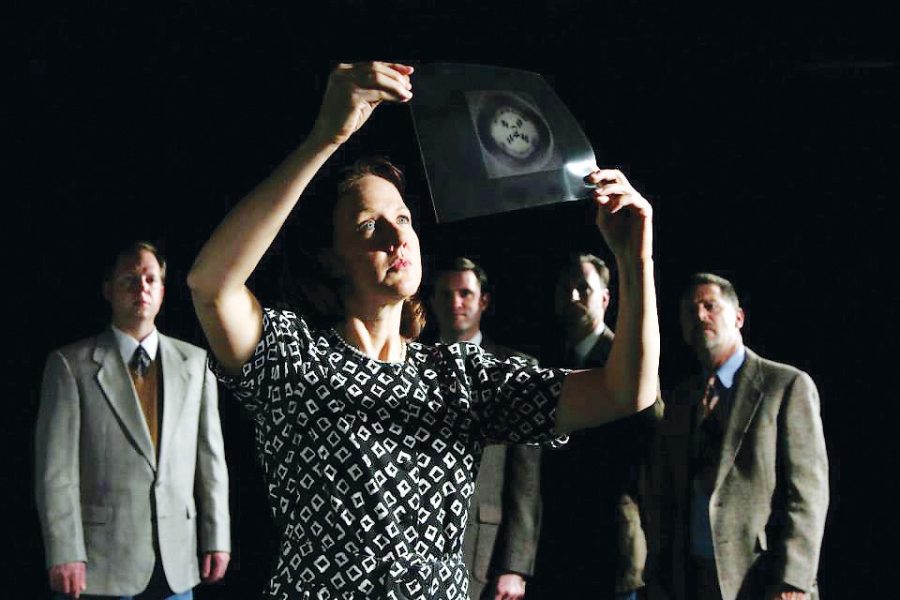“It’s the loneliest pursuit in the world, science.”
This line of dialogue from Live Theatre Workshop’s production of “Photograph 51” exemplifies the one-act narrative of the forgotten conflict between the scientists who uncovered DNA’s double-helix structure in 1950s England.
Although Anna Ziegler’s play is filled with plenty of scientific jargon, the heart of the story resides within the protagonist, Rosalind Franklin, and her passion for finding beauty in life’s greatest mysteries.
Based on the actual scientist from Notting Hill, London, Franklin is a hard-working, independent woman working in an era long before the term “feminism” became fashionable in our lexicon. Despite being excluded from the gridlocked boys club of British academia, Franklin finds pleasure in working alone in a laboratory.
The play is structured around memories from the perspective of Franklin’s friends and foes in the years leading up to and following her DNA discovery. These associates are a group of men who function as a traditional Greek chorus, moving around the main character to give bits of hindsight commentary to the audience.
This type of staging is aesthetically complementary to the play’s circumstances, as the men in Franklin’s life seem to hover over her, too afraid to reach out to a willingly standoffish woman.
Ziegler’s script carefully weaves these men together with the dual functions of character and narrator, but the Live Theatre Workshop’s black box stage’s layout doesn’t accommodate Ziegler’s disjointed world. The stage is crammed with furniture, and it is difficult to distinguish when a character is in the past from when they are in the present.
The production tries to counter the lack of physical space by manipulating lights and sound to help section off pieces of the nonlinear narrative. Characters frequently break off into personal monologues with a wealth of melancholy light accentuating shadows across their faces, and there is underscore of familiar music to emphasize their entrapped emotions.
These nonrealistic conventions border on abstract expressionism, which contrasts strangely with the history that the play attempts to dramatize. The play’s title is derived from the famous X-ray photograph Franklin took that confirmed her theories about DNA’s helical design.
To a contemporary audience, the design of DNA may seem like a trivial fact lost in a high school textbook, but Franklin’s discovery was considered revolutionary — and even lucrative. The X-marked photograph almost became the Holy Grail in the competitive pursuit for a Nobel Prize.
This race for fame and distinction introduces the central conflict between Franklin and her two antagonists, Francis Crick and James Watson. Based on the actual scientists who took all of the credit for determining DNA’s structure in their 1962 Nobel Prize speech, Crick and Watson are crafted as self-centered plagiarists.
Actor Nick Price takes Watson’s villainy one step too far. His exaggerated gestures make the character seem cartoonish, and he reduces the three-dimensionality of the real-life Watson to a Disney caricature.
Despite Price’s distracting performance, the rest of the ensemble nicely embraces the banter and wit of Ziegler’s text. An unexpected love triangle even arises between Franklin and two of her colleagues, one of whom is Maurice Wilkins, the man now blamed for leaking Franklin’s discovery to Watson and Crick.
By the end of the play, Ziegler has cleverly shifted the focus from Franklin to Wilkins. It’s an attempt to highlight the guilt Wilkins must bear, and again to reinforce the loneliness of this environment of sterile telescopes and test tubes.
The last scene is of Wilkins trying to reinvent a memory of him and Franklin seeing a production of “A Winter’s Tale,” but unlike the characters of William Shakespeare’s play, Wilkins is left alone with the everlasting regret of lost love.
These dramatic liberties are likely deviations from the actual events that took place in Franklin’s lab, but “Photograph 51” is still an educational story about the embittered battles over the mysterious molecules that make up our biology.
Live Theatre Workshop’s production team does its best to stage Ziegler’s complex material, and it certainly provides an informative piece of entertainment that supersedes the lectures of any ninth-grade biology teacher. The production runs every weekend through Mar. 22, with regular tickets starting at $18.









